Experimental Parametric Investigation of Nanosecond Laser-Induced Surface Graphitization of Nano-Crystalline Diamond
Abstract
:1. Introduction
2. Materials and Methods
3. Results and Discussion
3.1. Characteristics of Laser-Induced Graphitization of NCD
3.2. Effect of the Pulse Repetition Rate on the Graphitization of NCD
3.3. Effect of Laser Power on the Graphitization of NCD
3.4. Microgroove on NCD under Optimized Parameters
4. Conclusions
Author Contributions
Funding
Institutional Review Board Statement
Informed Consent Statement
Data Availability Statement
Conflicts of Interest
References
- Chaudhri, M.M. Indentation hardness of diamond single crystals, nanopolycrystal, and nanotwinned diamonds: A critical review. Diam. Relat. Mater. 2020, 109, 108076. [Google Scholar] [CrossRef]
- Katagiri, K.; Ozaki, N.; Umeda, Y.; Irifune, T.; Kamimura, N.; Miyanishi, K.; Kodama, R. Shock Response of Full Density Nanopolycrystalline Diamond. Phys. Rev. Lett. 2020, 125, 185701. [Google Scholar] [CrossRef] [PubMed]
- Tanigaki, K.; Ogi, H.; Sumiya, H.; Kusakabe, K.; Nakamura, N.; Hirao, M.; Ledbetter, H. Observation of higher stiffness in nanopolycrystal diamond than monocrystal diamond. Nat. Commun. 2013, 4, 2343. [Google Scholar] [CrossRef] [PubMed]
- Ikeda, K.; Sumiya, H. Optical properties of ultrapure nano-polycrystalline diamond. Jpn. J. Appl. Phys. 2016, 55, 120306. [Google Scholar] [CrossRef]
- Umezawa, H. Recent advances in diamond power semiconductor devices. Mater. Sci. Semicond. Process. 2018, 78, 147–156. [Google Scholar] [CrossRef]
- Wang, Y.; Shi, F.; Gasc, J.; Ohfuji, H.; Wen, B.; Yu, T.; Irifune, T. Plastic Deformation and Strengthening Mechanisms of Nanopolycrystalline Diamond. ACS Nano 2021, 15, 8283–8294. [Google Scholar] [CrossRef] [PubMed]
- Sumiya, H.; Harano, K. Micro-scale abrasion investigations of single-crystal diamonds using nano-polycrystalline diamond wheels. Diam. Relat. Mater. 2022, 126, 109108. [Google Scholar] [CrossRef]
- Gäbler, J.; Pleger, S. Precision and micro CVD diamond-coated grinding tools. Int. J. Mach. Tools Manuf. 2010, 50, 420–424. [Google Scholar] [CrossRef]
- Xiao, C.; Hsia, F.-C.; Sutton-Cook, A.; Weber, B.; Franklin, S. Polishing of polycrystalline diamond using synergies between chemical and mechanical inputs: A review of mechanisms and processes. Carbon 2022, 196, 29–48. [Google Scholar] [CrossRef]
- Fuentes-Fernandez, E.M.A.; Alcantar-Peña, J.J.; Lee, G.; Boulom, A.; Phan, H.; Smith, B.; Auciello, O. Synthesis and characterization of microcrystalline diamond to ultrananocrystalline diamond films via Hot Filament Chemical Vapor Deposition for scaling to large area applications. Thin Solid Film. 2016, 603, 62–68. [Google Scholar] [CrossRef]
- Thomas, E.L.H.; Nelson, G.W.; Mandal, S.; Foord, J.S.; Williams, O.A. Chemical mechanical polishing of thin film diamond. Carbon 2014, 68, 473–479. [Google Scholar] [CrossRef]
- Takayama, N.; Yan, J. Mechanisms of micro-groove formation on single-crystal diamond by a nanosecond pulsed laser. J. Mater. Process. Technol. 2017, 243, 299–311. [Google Scholar] [CrossRef]
- Cadot, G.B.J.; Billingham, J.; Axinte, D.A. A study of surface swelling caused by graphitisation during pulsed laser ablation of carbon allotrope with high content of sp3 bounds. J. Phys. D Appl. Phys. 2017, 50, 245301. [Google Scholar] [CrossRef]
- Ali, B.; Litvinyuk, I.V.; Rybachuk, M. Femtosecond laser micromachining of diamond: Current research status, applications and challenges. Carbon 2021, 179, 209–226. [Google Scholar] [CrossRef]
- Zhai, J.; Zhang, Q.; Zhu, Y. Picosecond laser ablation of polycrystalline CVD diamond. Opt. Laser Technol. 2022, 155, 108403. [Google Scholar] [CrossRef]
- Ali, B.; Xu, H.; Chetty, D.; Sang, R.T.; Litvinyuk, I.V.; Rybachuk, M. Laser-Induced Graphitization of Diamond Under 30 fs Laser Pulse Irradiation. J. Phys. Chem. Lett. 2022, 13, 2679–2685. [Google Scholar] [CrossRef] [PubMed]
- Trucchi, D.M.; Bellucci, A.; Girolami, M.; Mastellone, M.; Orlando, S. Surface Texturing of CVD Diamond Assisted by Ultrashort Laser Pulses. Coatings 2017, 7, 185. [Google Scholar] [CrossRef]
- Zhang, Z.; Zhang, Q.; Xu, J. The crack propagation and surface formation mechanism of single crystalline diamond by a nanosecond pulsed laser. J. Appl. Phys. 2021, 130, 113105. [Google Scholar] [CrossRef]
- Ohfuji, H.; Okuchi, T.; Odake, S.; Kagi, H.; Sumiya, H.; Irifune, T. Micro-/nanostructural investigation of laser-cut surfaces of single- and polycrystalline diamonds. Diam. Relat. Mater. 2010, 19, 1040–1051. [Google Scholar] [CrossRef]
- Zhao, L.; Song, C.; Zhang, J.; Huang, Y.; Zhang, C.; Liu, Y.; Sun, T. Growth of highly oriented graphite by ultraviolet nanosecond pulsed laser ablation of monocrystalline diamond. Appl. Surf. Sci. 2022, 578, 151995. [Google Scholar] [CrossRef]
- Okuchi, T.; Ohfuji, H.; Odake, S.; Kagi, H.; Nagatomo, S.; Sugata, M.; Sumiya, H. Micromachining and surface processing of the super-hard nano-polycrystalline diamond by three types of pulsed lasers. Appl. Phys. A 2009, 96, 833–842. [Google Scholar] [CrossRef]
- Kononenko, V.; Kononenko, T.; Pimenov, S.; Sinyavskii, M.; Konov, V.; Dausinger, F. Effect of the pulse duration on graphitisation of diamond during laser ablation. Quantum Electron. 2005, 35, 252–256. [Google Scholar] [CrossRef]
- Wu, M.; Guo, B.; Zhao, Q. Laser machining micro-structures on diamond surface with a sub-nanosecond pulsed laser. Appl. Phys. A 2018, 124, 1–9. [Google Scholar] [CrossRef]
- Mastellone, M.; Bolli, E.; Valentini, V.; Orlando, S.; Lettino, A.; Polini, R.; Trucchi, D.M. Surface Nanotexturing of Boron-Doped Diamond Films by Ultrashort Laser Pulses. Micromachines 2023, 14, 389. [Google Scholar] [CrossRef] [PubMed]
- Sartori, A.F.; Orlando, S.; Bellucci, A.; Trucchi, D.M.; Abrahami, S.; Boehme, T.; Buijnsters, J.G. Laser-Induced Periodic Surface Structures (LIPSS) on Heavily Boron-Doped Diamond for Electrode Applications. ACS Appl. Mater. Interfaces 2018, 10, 43236–43251. [Google Scholar] [CrossRef] [PubMed]
- Dawedeit, C.; Kucheyev, S.O.; Shin, S.J.; Willey, T.M.; Bagge-Hansen, M.; Braun, T.; Biener, J. Grain size dependent physical and chemical properties of thick CVD diamond films for high energy density physics experiments. Diam. Relat. Mater. 2013, 40, 75–81. [Google Scholar] [CrossRef]
- Granados, E.; Martínez-Calderon, M.; Gomez-Aranzadi, M.; Rodríguez, A.; Olaizola, S. Photonic structures in diamond based on femtosecond UV laser induced periodic surface structuring (LIPSS). Opt. Express 2017, 25, 15330. [Google Scholar] [CrossRef] [PubMed]
- Pimenov, S.M.; Zavedeev, E.V.; Arutyunyan, N.R.; Jaeggi, B.; Neuenschwander, B. Femtosecond laser-induced periodic surface structures on diamond-like nanocomposite films. Diam. Relat. Mater. 2022, 130, 109517. [Google Scholar] [CrossRef]
- Barbos, C.; Blanc-Pelissier, D.; Fave, A.; Blanquet, E.; Crisci, A.; Fourmond, E.; Lemiti, M. Characterization of Al2O3 Thin Films Prepared by Thermal ALD. Energy Procedia 2015, 77, 558–564. [Google Scholar] [CrossRef]
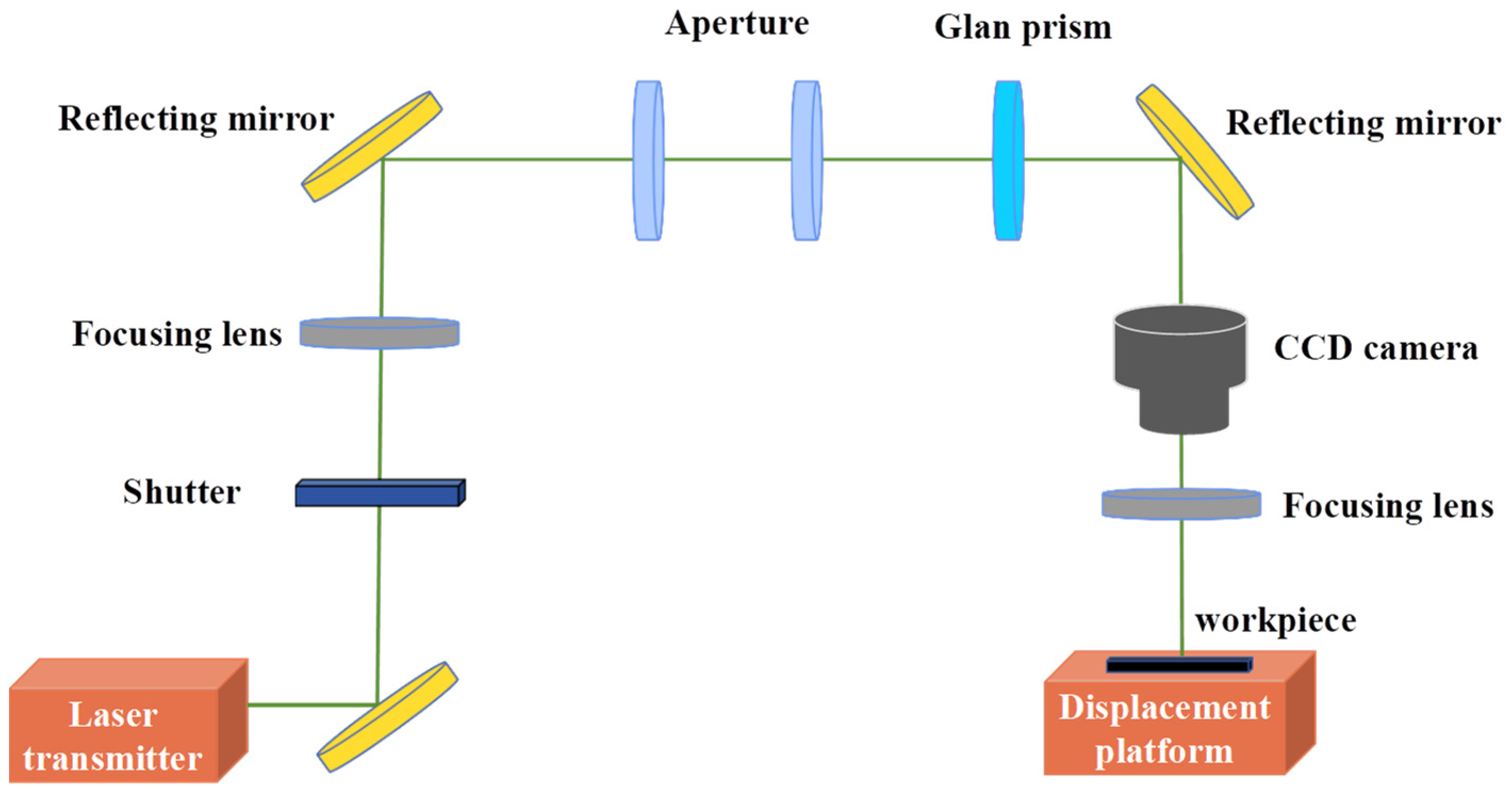
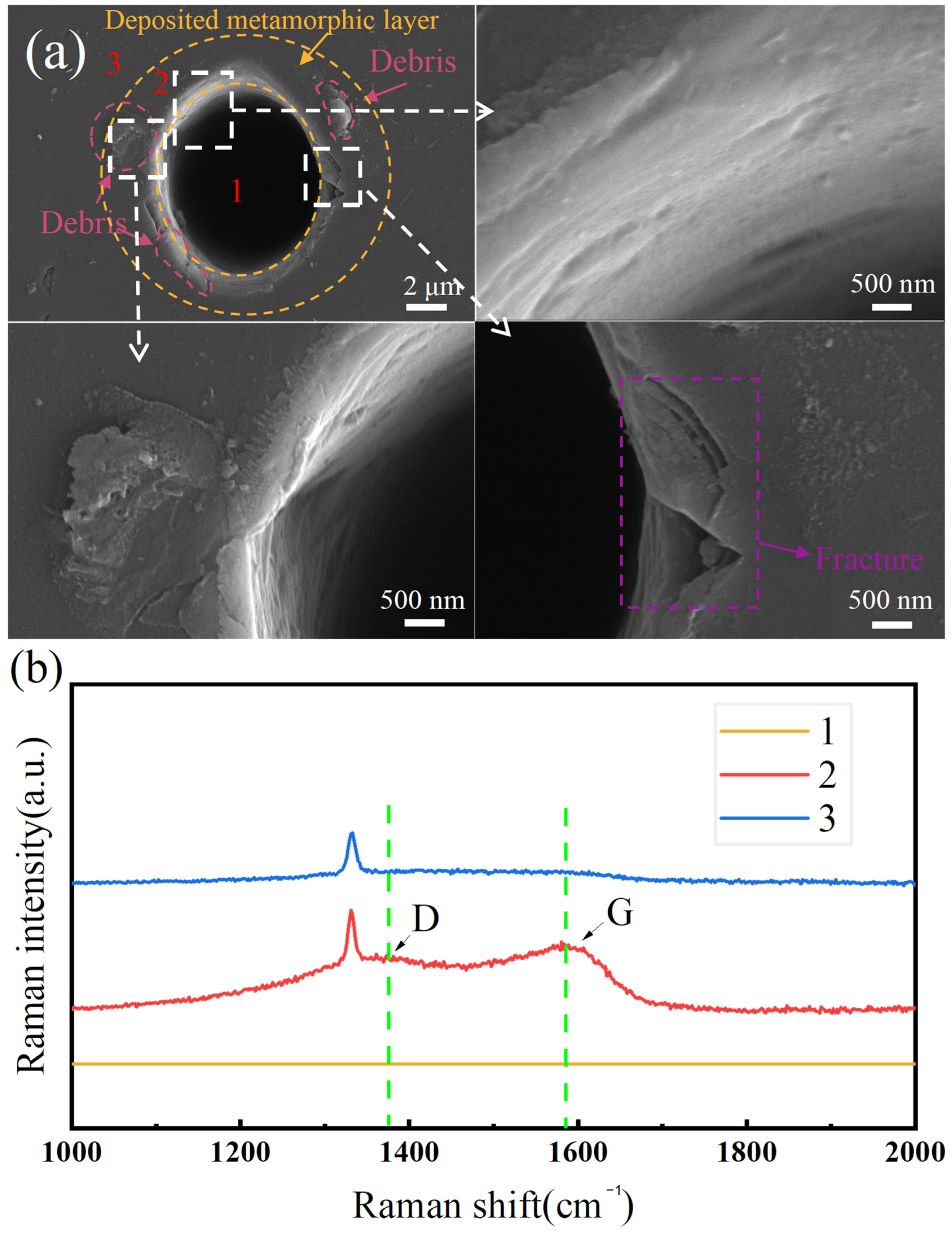
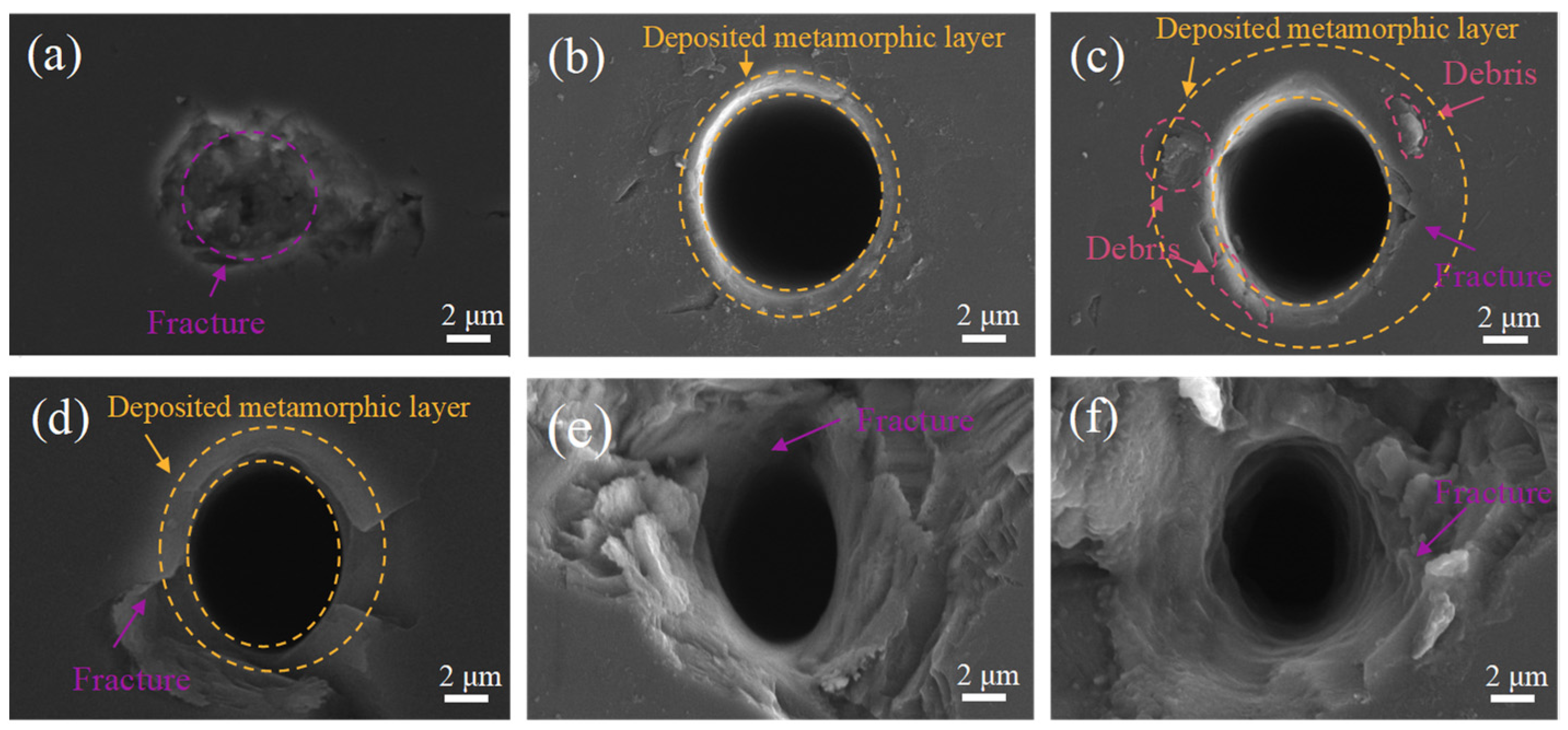
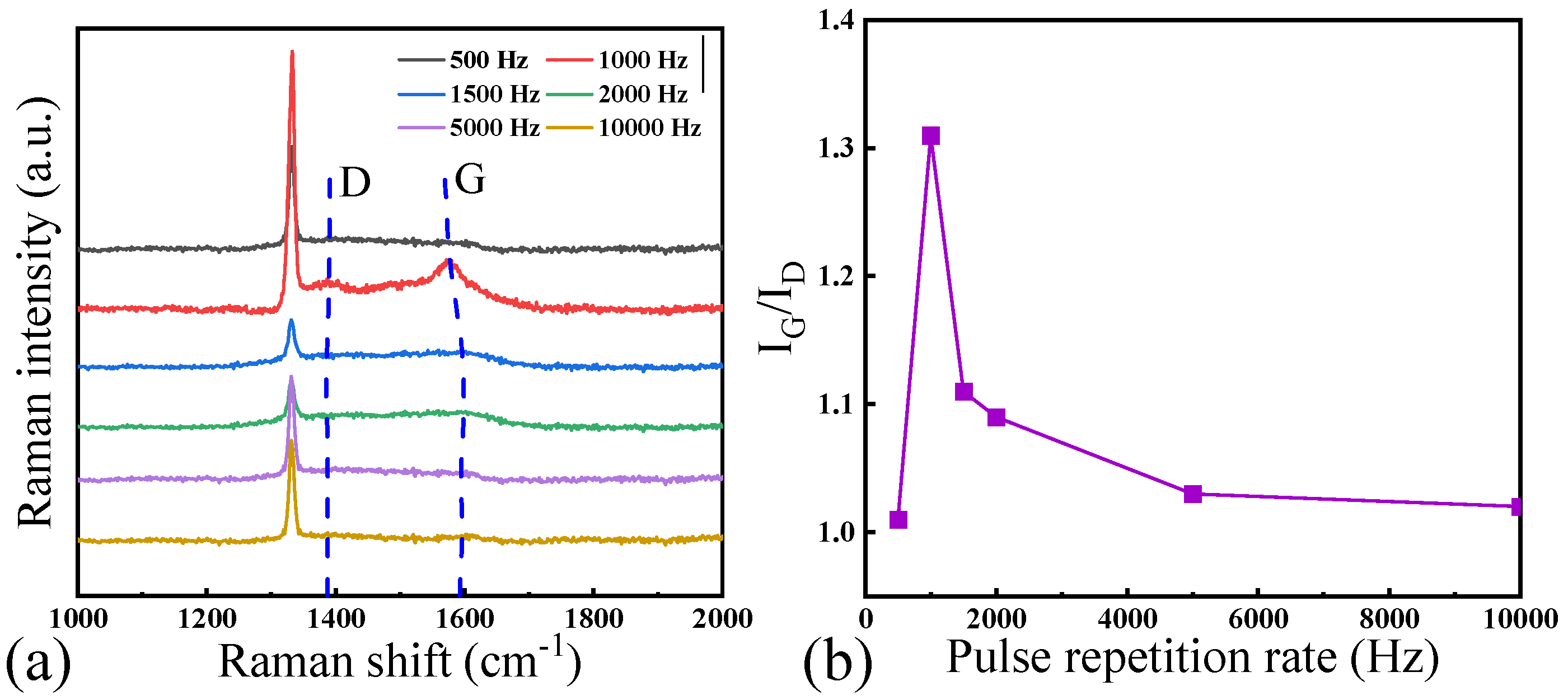
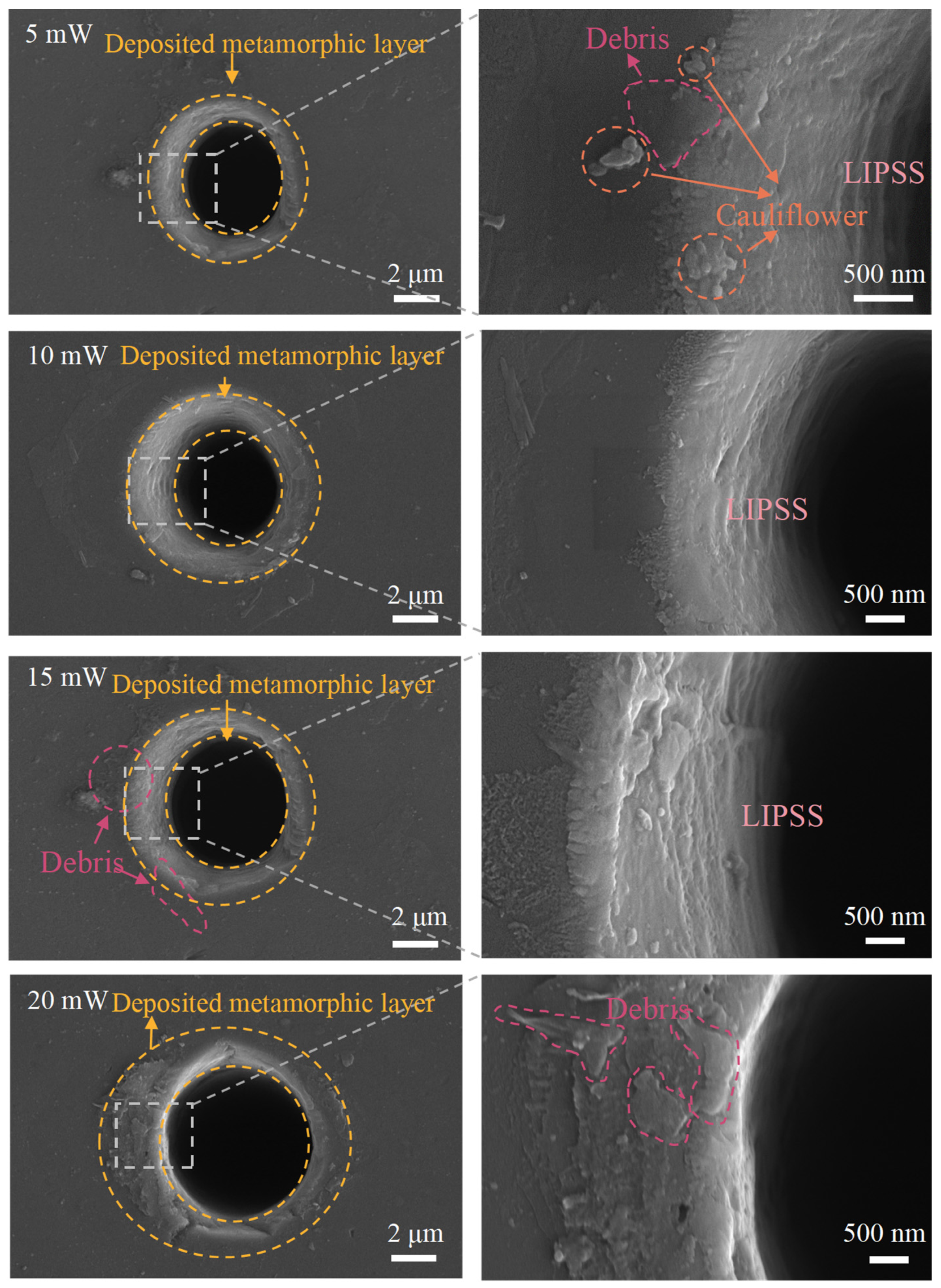
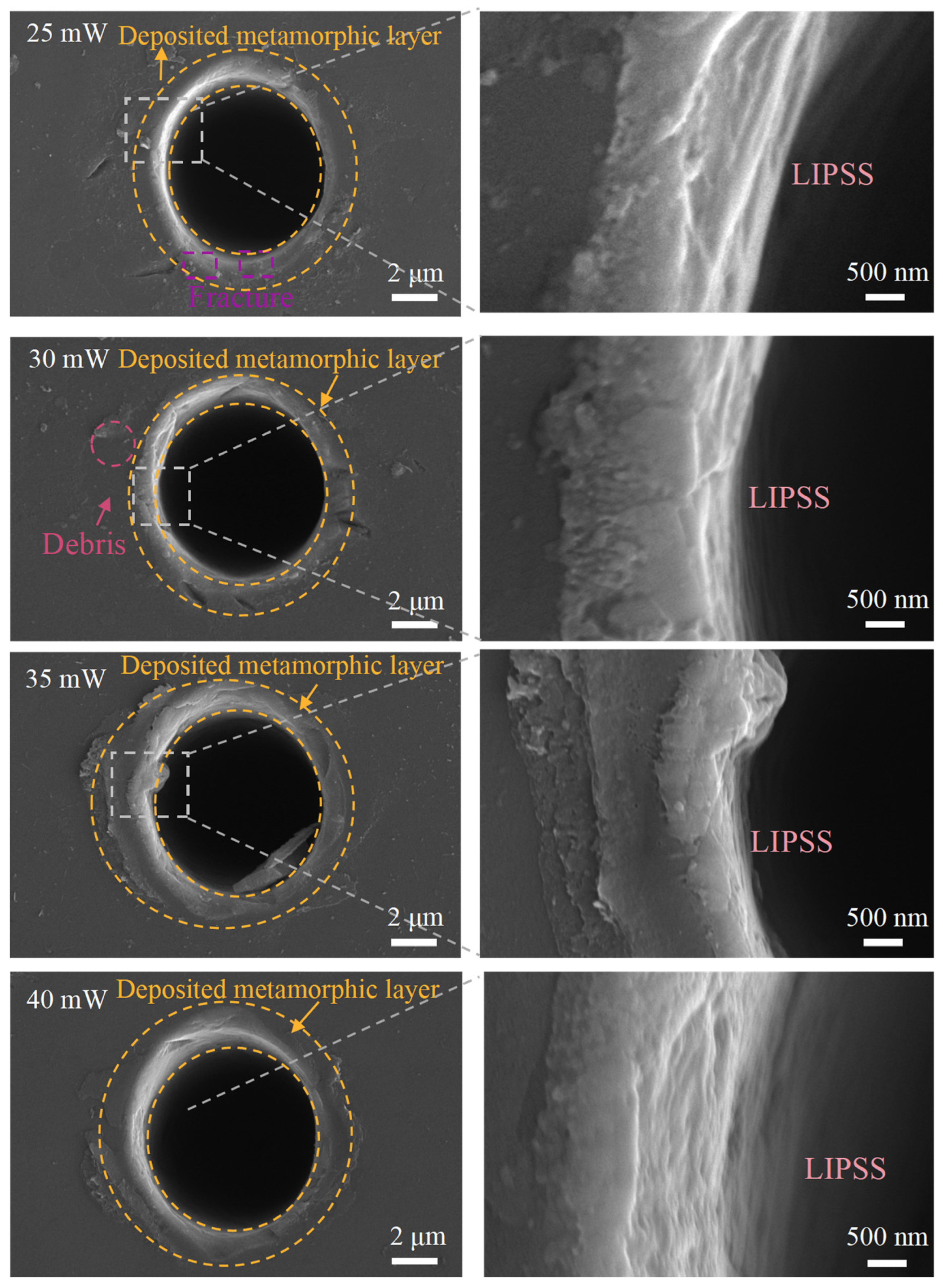
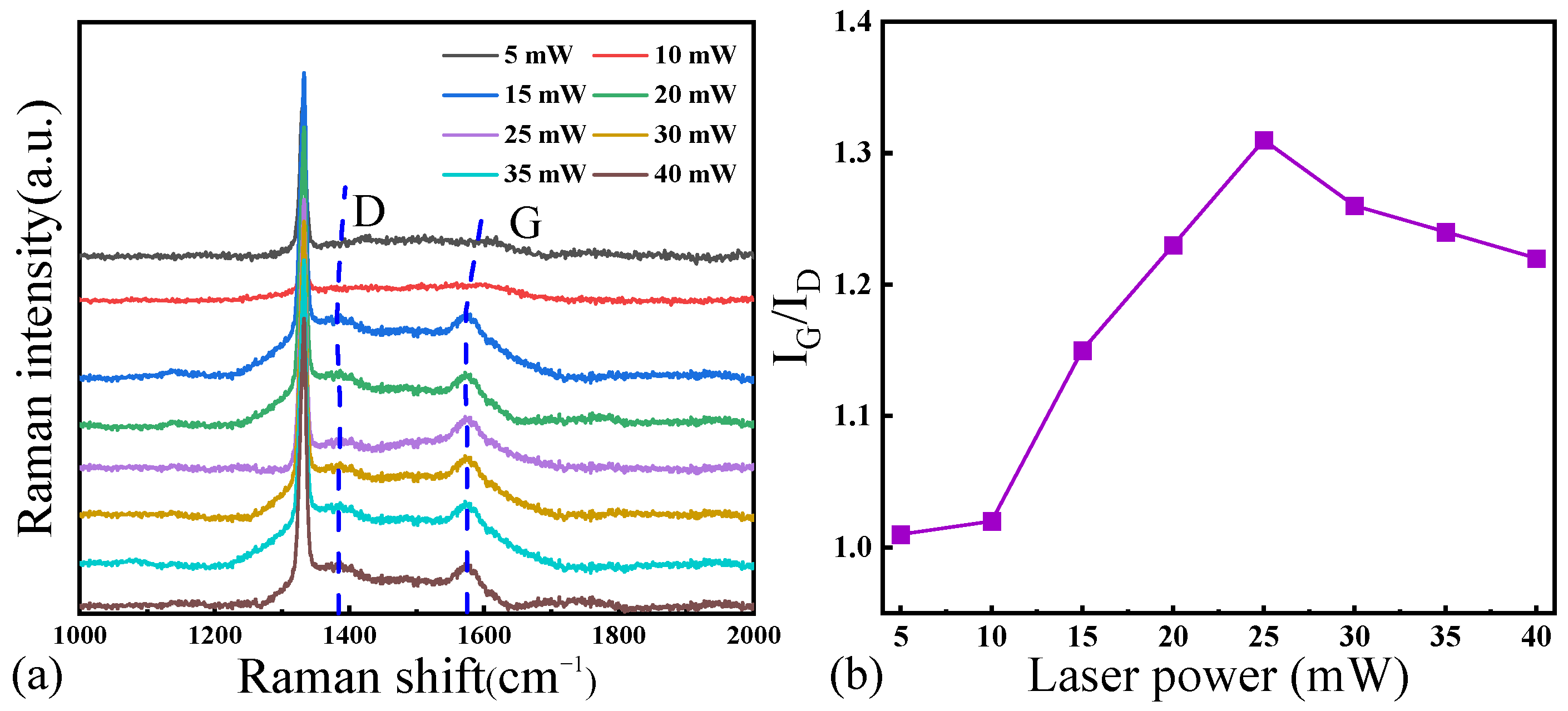

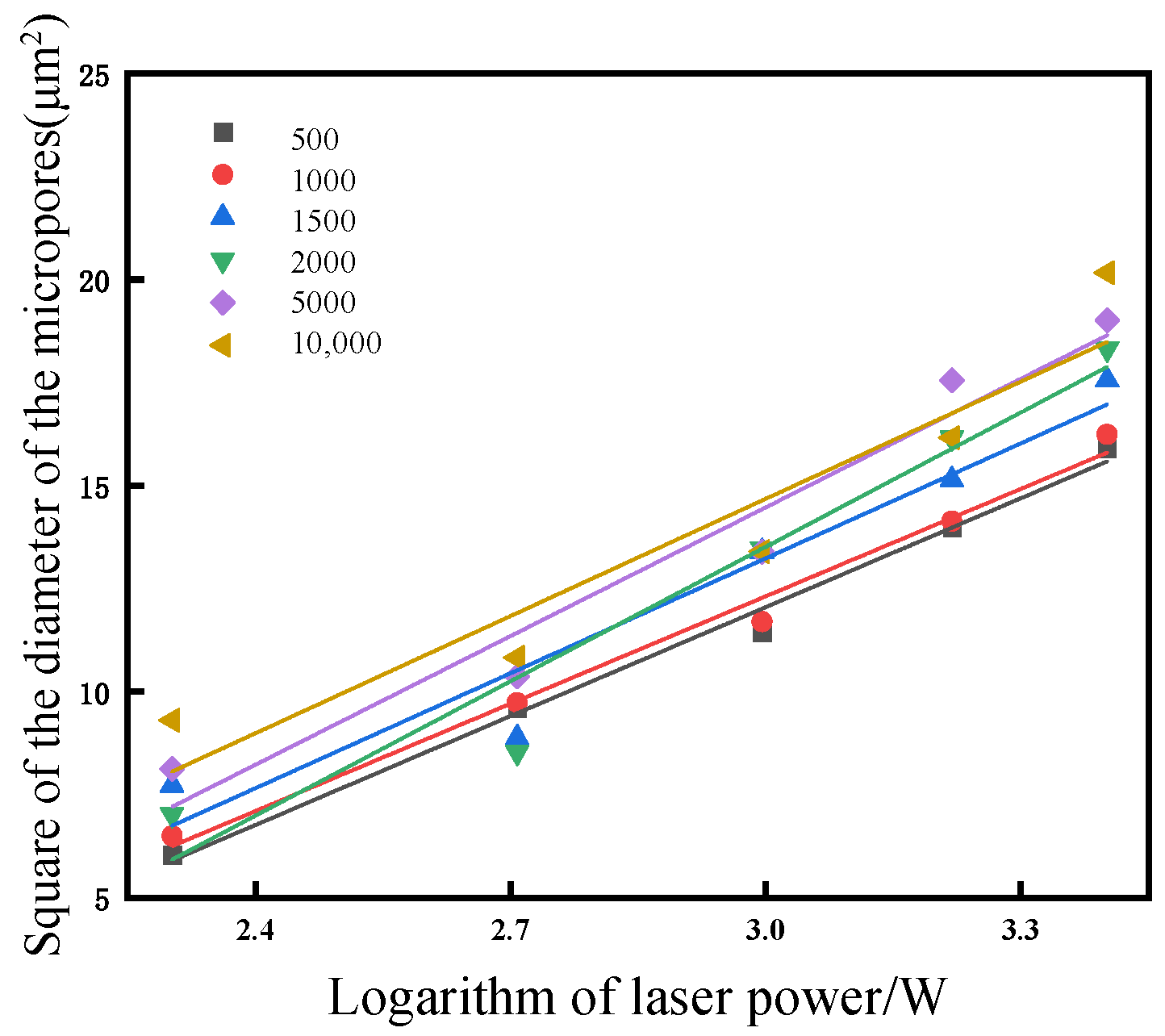
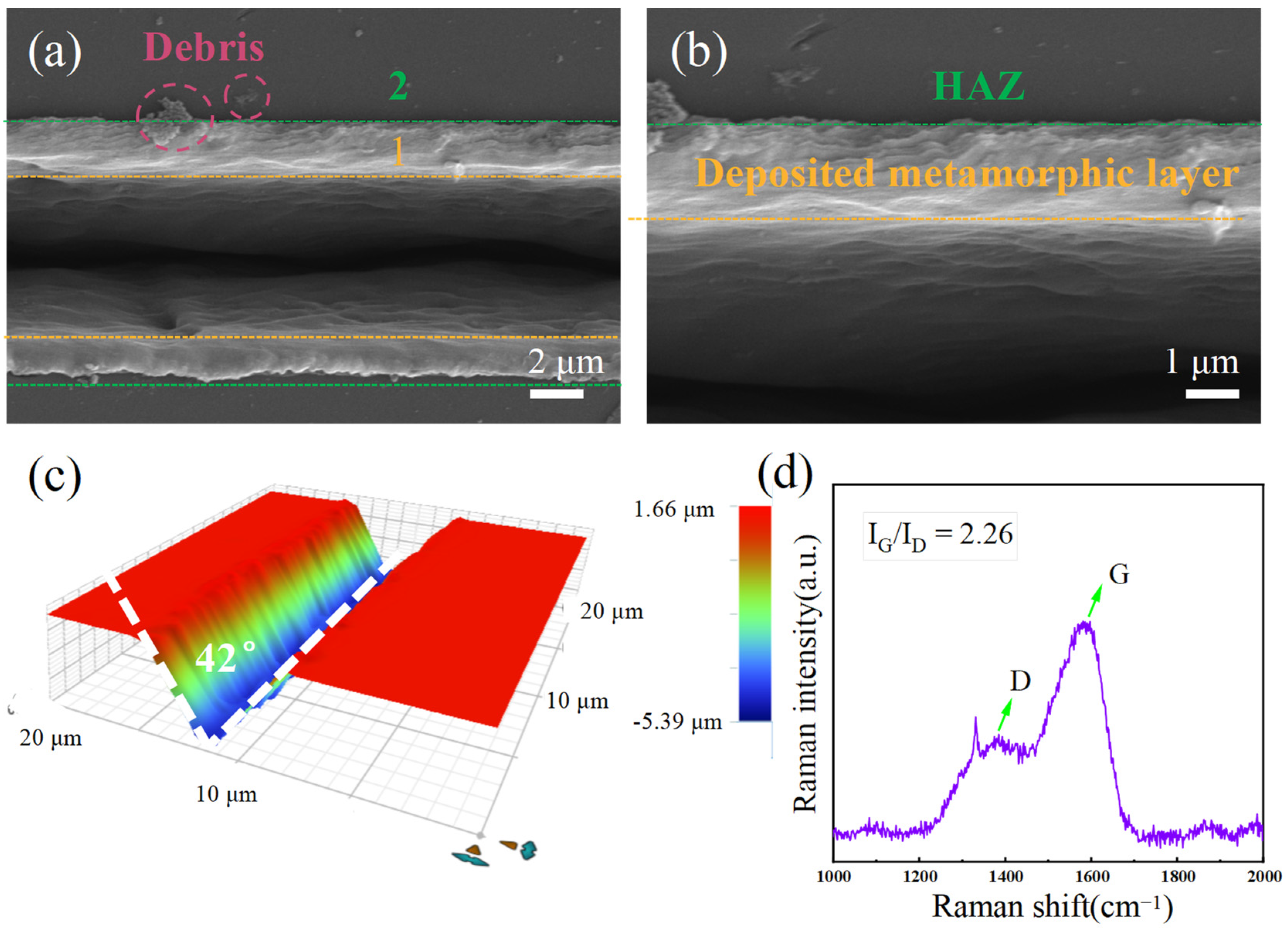
Disclaimer/Publisher’s Note: The statements, opinions and data contained in all publications are solely those of the individual author(s) and contributor(s) and not of MDPI and/or the editor(s). MDPI and/or the editor(s) disclaim responsibility for any injury to people or property resulting from any ideas, methods, instructions or products referred to in the content. |
© 2024 by the authors. Licensee MDPI, Basel, Switzerland. This article is an open access article distributed under the terms and conditions of the Creative Commons Attribution (CC BY) license (https://creativecommons.org/licenses/by/4.0/).
Share and Cite
Yuan, H.; Zhao, L.; Zhang, J. Experimental Parametric Investigation of Nanosecond Laser-Induced Surface Graphitization of Nano-Crystalline Diamond. Materials 2024, 17, 2704. https://doi.org/10.3390/ma17112704
Yuan H, Zhao L, Zhang J. Experimental Parametric Investigation of Nanosecond Laser-Induced Surface Graphitization of Nano-Crystalline Diamond. Materials. 2024; 17(11):2704. https://doi.org/10.3390/ma17112704
Chicago/Turabian StyleYuan, Huixin, Liang Zhao, and Junjie Zhang. 2024. "Experimental Parametric Investigation of Nanosecond Laser-Induced Surface Graphitization of Nano-Crystalline Diamond" Materials 17, no. 11: 2704. https://doi.org/10.3390/ma17112704




